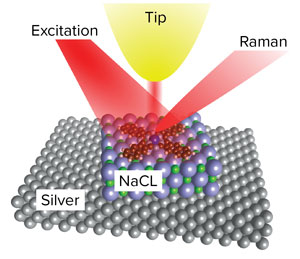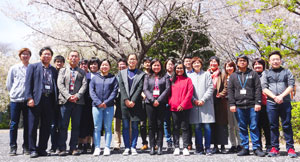Mar. 27, 2020 Research Highlight Chemistry
Just add salt to enhance the spatial resolution of single-molecule Raman spectroscopy
A thin substrate of sodium chloride aids the spectroscopic resolution of single-molecule vibrations
 Figure 1: Schematic of the experimental set up. The sample, a molecule of copper naphthalocyanine (X-shaped structure) is adsorbed on a layer of sodium chloride (NaCl), which is deposited on a silver substrate. The tip scans the molecule and a laser beam excites the sample, the Raman spectrum of which is detected. © 2020 RIKEN Surface and Interface Science Laboratory
Figure 1: Schematic of the experimental set up. The sample, a molecule of copper naphthalocyanine (X-shaped structure) is adsorbed on a layer of sodium chloride (NaCl), which is deposited on a silver substrate. The tip scans the molecule and a laser beam excites the sample, the Raman spectrum of which is detected. © 2020 RIKEN Surface and Interface Science LaboratoryScientists at RIKEN have been able to detect vibrations of a single molecule, allowing them to produce different maps of the molecule for different vibrations1. This technique is promising for probing the chemical properties of materials on a single-molecule level and for discovering new nanomaterials.
Raman spectroscopy is commonly used to study the vibrations of molecules, but its resolution is limited by the wavelength of the light used to irradiate the sample. This becomes problematic for the study of very small systems such as single molecules.
Tip-enhanced Raman spectroscopy (TERS) overcomes this problem by using the tip of a scanning tunneling microscope (STM) to enhance the resolution. But this method has its own limitations—it enhances molecular vibrations that are parallel to the tip much more than those perpendicular to the tip and it can alter the chemical properties of the sample.
Now, Yousoo Kim and Rafael Jaculbia from the RIKEN Surface and Interface Science Laboratory and their co-workers have overcome both these limitations of STM-TERS.
They did this by adding a thin layer of sodium chloride between a silver substrate and the sample—in this case, an isolated molecule of copper naphthalocyanine (Fig. 1). By scanning the tip across the molecule, the team could obtain maps of the molecule that differed depending on the molecular vibration used to produce the map.
 Yousoo Kim (second from left) and Rafael Jaculbia (third from right) and their co-workers have shown that adsorbing a single molecule on a thin layer of an insulating salt deposited on a metallic substrate improves the spatial resolution of tip-enhanced Raman spectroscopy. © 2020 RIKEN
Yousoo Kim (second from left) and Rafael Jaculbia (third from right) and their co-workers have shown that adsorbing a single molecule on a thin layer of an insulating salt deposited on a metallic substrate improves the spatial resolution of tip-enhanced Raman spectroscopy. © 2020 RIKEN In this technique, because the molecule is not in direct contact with the silver surface, vibrations that are perpendicular to the tip could be detected just as well as those parallel to the tip. In addition, since the sodium chloride layer physically separated the sample and the silver substrate, the chemical properties of the sample remained unchanged.
“We didn’t need to perturb the system to get the maps; our results showed that the molecule remains in its original electronic state by keeping the tip farther from the molecule,” explains Jaculbia. “With this strategy, we are able to keep the molecule’s intrinsic properties, which is useful for investigating the unperturbed properties of a single molecule.”
“Our technique is a truly non-invasive probe with the capabilities of both high chemical sensitivity and nanoscale spatial resolution,” comments Kim. “Such a technique is indispensable for discovering new nanoscale materials and investigating the intrinsic chemical properties of materials.”
“We are looking forward to seeing our technique be used to identify new molecules based on their vibrational modes, similar to how biometric scanners process human fingerprints,” adds Jaculbia.
Related contents
- On-surface cycloaddition reactions watched every step of the way
- New mechanism allows lower energy requirement for OLED displays
- Scanning tunneling microscopy reveals molecular dissociation induced by localized surface plasmons
References
- 1. Jaculbia, R. B., Imada, H., Miwa, K., Iwasa, T., Takenaka, M., Yang, B., Kazuma, E., Hayazawa, N., Taketsugu, T. & Kim, Y. Single-molecule resonance Raman effect in a plasmonic nanocavity. Nature Nanotechnology 15, 105–110 (2020). doi: 10.1038/s41565-019-0614-8
